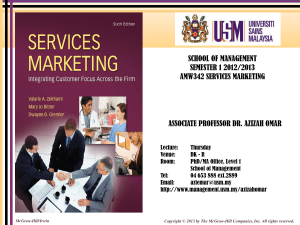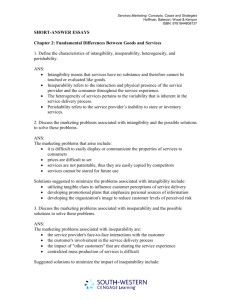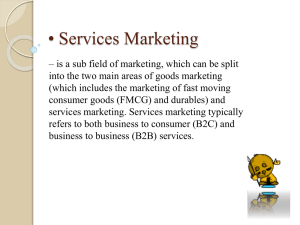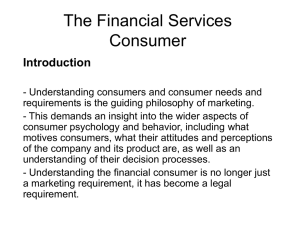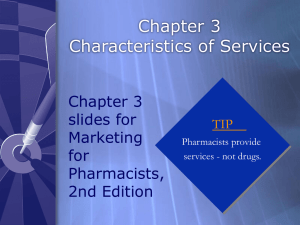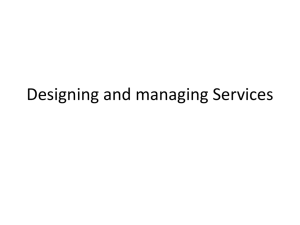The Opportunities and Problems in Making Services More Tangible
advertisement
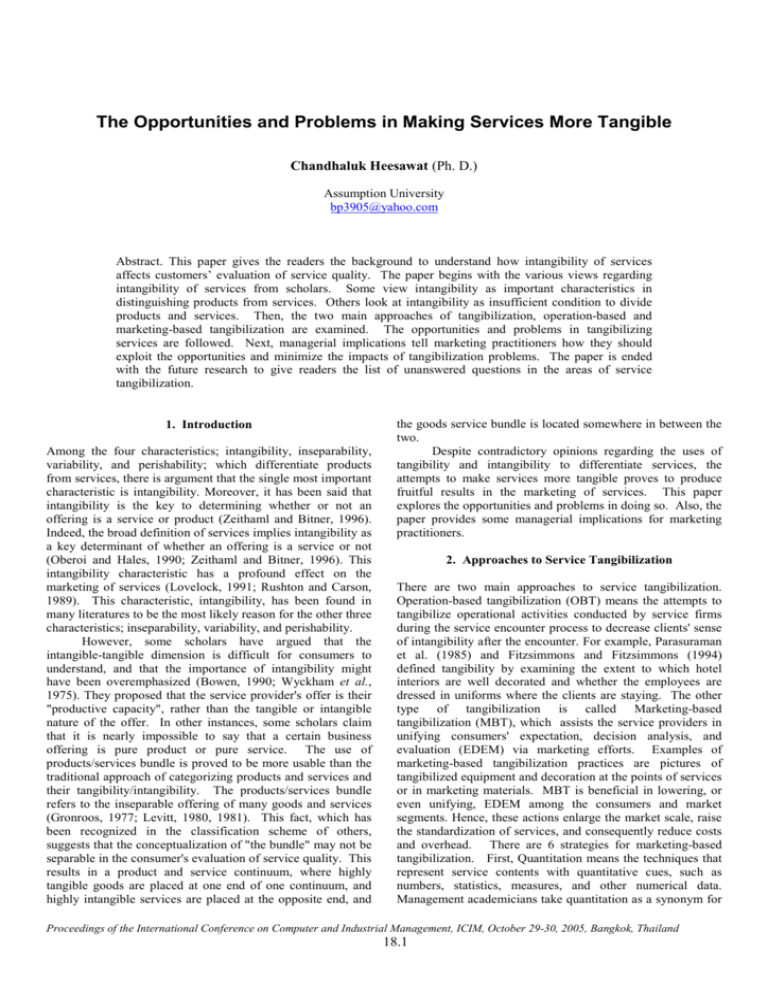
The Opportunities and Problems in Making Services More Tangible Chandhaluk Heesawat (Ph. D.) Assumption University bp3905@yahoo.com Abstract. This paper gives the readers the background to understand how intangibility of services affects customers’ evaluation of service quality. The paper begins with the various views regarding intangibility of services from scholars. Some view intangibility as important characteristics in distinguishing products from services. Others look at intangibility as insufficient condition to divide products and services. Then, the two main approaches of tangibilization, operation-based and marketing-based tangibilization are examined. The opportunities and problems in tangibilizing services are followed. Next, managerial implications tell marketing practitioners how they should exploit the opportunities and minimize the impacts of tangibilization problems. The paper is ended with the future research to give readers the list of unanswered questions in the areas of service tangibilization. 1. Introduction Among the four characteristics; intangibility, inseparability, variability, and perishability; which differentiate products from services, there is argument that the single most important characteristic is intangibility. Moreover, it has been said that intangibility is the key to determining whether or not an offering is a service or product (Zeithaml and Bitner, 1996). Indeed, the broad definition of services implies intangibility as a key determinant of whether an offering is a service or not (Oberoi and Hales, 1990; Zeithaml and Bitner, 1996). This intangibility characteristic has a profound effect on the marketing of services (Lovelock, 1991; Rushton and Carson, 1989). This characteristic, intangibility, has been found in many literatures to be the most likely reason for the other three characteristics; inseparability, variability, and perishability. However, some scholars have argued that the intangible-tangible dimension is difficult for consumers to understand, and that the importance of intangibility might have been overemphasized (Bowen, 1990; Wyckham et al., 1975). They proposed that the service provider's offer is their "productive capacity", rather than the tangible or intangible nature of the offer. In other instances, some scholars claim that it is nearly impossible to say that a certain business offering is pure product or pure service. The use of products/services bundle is proved to be more usable than the traditional approach of categorizing products and services and their tangibility/intangibility. The products/services bundle refers to the inseparable offering of many goods and services (Gronroos, 1977; Levitt, 1980, 1981). This fact, which has been recognized in the classification scheme of others, suggests that the conceptualization of "the bundle" may not be separable in the consumer's evaluation of service quality. This results in a product and service continuum, where highly tangible goods are placed at one end of one continuum, and highly intangible services are placed at the opposite end, and the goods service bundle is located somewhere in between the two. Despite contradictory opinions regarding the uses of tangibility and intangibility to differentiate services, the attempts to make services more tangible proves to produce fruitful results in the marketing of services. This paper explores the opportunities and problems in doing so. Also, the paper provides some managerial implications for marketing practitioners. 2. Approaches to Service Tangibilization There are two main approaches to service tangibilization. Operation-based tangibilization (OBT) means the attempts to tangibilize operational activities conducted by service firms during the service encounter process to decrease clients' sense of intangibility after the encounter. For example, Parasuraman et al. (1985) and Fitzsimmons and Fitzsimmons (1994) defined tangibility by examining the extent to which hotel interiors are well decorated and whether the employees are dressed in uniforms where the clients are staying. The other type of tangibilization is called Marketing-based tangibilization (MBT), which assists the service providers in unifying consumers' expectation, decision analysis, and evaluation (EDEM) via marketing efforts. Examples of marketing-based tangibilization practices are pictures of tangibilized equipment and decoration at the points of services or in marketing materials. MBT is beneficial in lowering, or even unifying, EDEM among the consumers and market segments. Hence, these actions enlarge the market scale, raise the standardization of services, and consequently reduce costs and overhead. There are 6 strategies for marketing-based tangibilization. First, Quantitation means the techniques that represent service contents with quantitative cues, such as numbers, statistics, measures, and other numerical data. Management academicians take quantitation as a synonym for Proceedings of the International Conference on Computer and Industrial Management, ICIM, October 29-30, 2005, Bangkok, Thailand 18.1 clearness, preciseness, accuracy, definitude, and even explicity (David, 1999). From the practical perspective, service cues such as price, history of the providers, financial and capital conditions, amount of employees and existing clients, and other quantifiable information are the practices (Grove et al., 1995). If services can be portrayed and illustrated with quantitative cues, then it is easy for consumers to perceive exact conditions of services, and hereafter feel the services to be tangible. Second comes ranking, which is defined as a service provider's relative order in contrast with competitors or its counterparts by comparing the service contents. The ranking for top 50 education institutes is a typical example of ranking. Third, factualization is the technique that service providers use to illustrate their services by a literal proclaimed statement, illustration, and representation such as figures, pictures, and images, properly setting and equipping at a point of service and a demonstration of services, among others. Fourth, substantialization is the technique for presenting a concrete abstract image and invisible resource of service providers. At the fifth position lies, word-of-mouth effect (WOM), which is an essential element in the academy of consumer behaviors and service marketing. WOM can help to forge a referral network to deliver values and benefits of services. WOM is helpful in lowering consumers' perception of risk, reducing suspicion toward the services, and stimulating them to switch brands and unify EDEM differences among the consumers. In practice, WOM indeed represents great effects in promotional activities. Lastly, information frequency refers to the amount and density of service information delivered to consumers, including frequency of advertising, the number of visiting times by the sales force, and the frequency of provider-client encounters. In marketing-related fields, the literature always asserts the effects of a large amount and high density of information (Jacoby, 1984; Keller and Staelin, 1987). 3. The Opportunities Making services more tangible seems to ease up the evaluation of service quality. When services are more tangible, the degree of their variability will be significantly reduced, making the evaluation of service quality more objective. Service quality is normally measured by the level of discrepancy between consumer expectations or desires and their perceptions of what they received, as described by the SERVQUAL scale. According to SERVQUAL, there are five dimensions by which consumers evaluate service quality: Tangibles, Reliability, Responsiveness, Assurance, and Empathy. In case service transactions are divided into 3 phases: Pre-transaction, transaction, and Post-transaction. Reliability largely concerns whether the outcome of service delivery was as promised. The other four dimensions concern the process of service delivery, or how the service was delivered (the main transaction) (Berry and Parasuraman, 1991). According to the SERVQUAL model, customer assessments of service quality result from a comparison of service expectations with actual performance. In the pre-transaction element of service provision, tangibilization plays an important role. Service marketers face a significant challenge when it comes to communicating the intangible benefits of a service to their target audience (Mattila, 2000). Hence, the proposition that advertising should strive to add tangibility to the service offering (Berry and Clark, 1986; Onkvisit and Shaw, 1989; Stafford, 1996) is very common in service literature. Ostensibly, such an effort can help customers mentally grasp a product whose core lacks a physical reality (George and Berry, 1981; Shostack, 1977; Upah, 1983). Further, adding tangibility through advertising may help to address customers' high degree of perceived risk with service products (Bateson, 1995; Clow et al., 1999; Guseman, 1981; Lovelock and Wright, 1999; Murray, 1991; Zeithaml, 1981). Many research studies propose that intangibility makes consumers feel risky, decreases trust to providers, and forces each consumer to form his/her own psychological condition (Bateson, 1977; Guseman, 1981), thus producing unmet consumer satisfaction (Bebco, 2001). Service tangibilization could decrease consumers' sense of risk and uncertainty toward services before their consumption. Intangibility also makes it difficult for consumers to form an expectation toward services or form them by mistake, hence the service providers fail to grasp consumers' expectations precisely. Most studies in the related literature consider expectation as a major antecedent of consumer satisfaction (Oliver. 1980; Bebco, 2001). If consumers are not able to form their expectation correctly before the services are provided, even if the service quality is good, then it is possible that consumers' evaluation toward service quality will be misled or hindered due to a misexpectation. Therefore, tangibilization practices are helpful to build consumers' expectation, and therefore raise their service satisfaction. When the intangibility of the process and outcome of a service increase, the consumers' expectations of quality also increase. Specifically, the consumers' expectations increase for reliability, assurance, responsiveness and empathy. As the desired expectations increase, there is a greater chance that the provider will not be able to meet them. In conclusion, tangibility helps form a more objective expectation about service quality. It reduces the chance of customers’ misperception of service quality. With tangibility, there is more chance for firms to satisfy customers leading to the chance to earn more profits. 4. The Problems The approach to which services are tangibilized may lead to problems. Operation-based tangibilization fails to give "predetermined advantages" to providers. It can only satisfy existing consumers while neglecting to attract potential ones (Mullins, 1993). In the same way, because intangibility leads to divergent expectation, decision analysis, and evaluation models (EDEM) among consumers (Bateson, 1977; Guseman, 1981), tangibilization could assist to unify, or at least to lower, the EDEM difference level. However, operation-based tangibilization, at most, helps existing consumers to evaluate the services, while it fails to converge EDEM among consumers. Operation-based tangibilization might be effective in offering better consumer evaluations toward service quality, yet it fails to help to converge consumers' EDEM, especially potential consumers. Firms utilizing only OBT have lower Special Issue of the International Journal of the Computer, the Internet and Management, Vol. 13 No.SP2, October, 2005 18.2 chance to increase customer satisfaction compared with those using MBT or MBT in combination with OBT. 5. Managerial Implications Expectations play a major role in determining consumers' post-consumption service quality evaluations. It is therefore important that the service marketer understands these expectations across the intangibility continuum. When service providers know the consumer's quality expectations, they are in a position to develop marketing strategies for service delivery. At this point, it appears that the first task for the service provider is to define adequately the service which is being delivered to the consumer. One must determine whether the outcome of the service act results in a tangible possession, an intangible or a service - product bundle. Next the service provider must determine whether the process is or is not experienced by the consumer. The tangibility index and the tangibility-intangibility matrix are a good starting point for this analysis. Understanding the range of consumer experiences and service outcomes as they relate to intangibility will assist the service provider in planning strategic marketing options for the service. If intangibility increases a consumer's perception of risk, then the promise of reliability should reduce it. Being reliable and becoming known for reliability in the service arena reduces a customer's expectations by reducing the need for service recovery (Berry and Parasuraman, 1991). However, businesses need to be cautious in promoting their reliability. Overstating or exaggerating claims concerning reliability can have the effect of raising consumer expectations unnecessarily. Businesses should work on being reliable first, then work on letting the consumers know about it through MBT. Insuring reliability means a management commitment to service quality. As in the production of tangibles, the production of intangibles requires standardization without compromising customization potential. Standardization of services requires the use of hard and soft technologies to provide consistent service to customers. Hard technologies, or replacing company personnel with machines, can help insure reliability of routine tasks. This also helps free company personnel to interact with customers. Soft technologies, or using a formal protocol for handling routine work, also helps insure the quality performance of services. As intangibility of the service increases, consumer expectations increase. Therefore, standardization should be implemented whenever possible in order to meet the consumers' increased expectations for reliability. Once reliability has been established, becoming known for reliability can be achieved both by consumer wordof-mouth communication and strategic marketing efforts. A service can increase the consumers' perception of the reliability of a service through both explicit and implicit service promises. Implicit service promises may be represented by tangibles and serve as evidence or cues for quality. These cues which lead to inferences about what the service should or will be, serve as evidence of quality thereby reducing risk for the consumer (Berry and Parasuraman, 1991). Cues for reliability will take on a different level of importance for each service. The implicit cues which serve as evidence of quality for a hospital may be sparkling clean facilities and white uniforms (Bebko and Downing, 1994). These same cues will probably not have the same impact on a consumer's perception of reliability for an auto mechanic as they do for a hospital. Each service needs to undertake the task of determining which cues are relevant and connote reliability to the consumer. But what if the service fails to deliver what the consumer expects? While the probability of loss occurring decreases with increased reliability, up to one half of service resolutions fail (Andreason and Best, 1977). Many of the criteria which consumers use in their evaluation involve how well they are able to recover if service failure occurs. Reducing the risk of loss (unreliable service delivery) is a matter of decreasing the value of the potential loss and/or reducing the probability of a loss occurring. 6. Future Research Research findings on intangibility, risk, uncertainty and expectations show mixed conclusions. While a recent study has shown that uncertainty is negatively associated with prepurchase expectations in industrial buying situations (Paterson et al., 1997), risk management principles state that an investor's expectation for a high rate of return should increase as the probability of loss increases. The association of intangible services, uncertainty, risk and expectations is an area yet to be examined in the service literature. The degree of tangibility or intangibility does have a significant effect on consumers' perceptions of service quality. The present research indicates that the argument in services marketing regarding the relative importance of tangible and intangible elements is more complex than the current literature has suggested. The importance of tangibility differs among various service industries. It has been more than three decades since academics began to realize the importance of tangibility and intangibility. However, an understanding of tangibility and intangibility in service industries is still in its infancy. Certain questions present themselves. How can the tangible elements be best demonstrated to meet customers' expectations? What are the antecedents of customers' perceptions of tangibility and intangibility? How is it possible to close the gap between customers and service providers in perceptions of the importance of tangibility? The relationship between tangibles and other service quality dimensions, and the effect of tangibility and intangibility on customer expectations and perceived service quality, are fruitful areas for further research. 7. Conclusions Understanding the intangibility of a particular service appears to have some level of importance in understanding consumer quality expectations. Managing those expectations means managing the risks a consumer faces when buying a particular service. The service provider who is successful in managing these risks will make it possible for consumers to paint a realistic set of expectations for service quality. Proceedings of the International Conference on Computer and Industrial Management, ICIM, October 29-30, 2005, Bangkok, Thailand 18.3 8. References Andreason, A., Best A. 1977, “Consumers complain-does business respond?”. Harvard Business Review, 93-101. Bateson, J., 1977, "Do we need service marketing", Eiglier, P., Langeard, E., Lovelock, C., Bateson, J., Marketing Services: New Insights, Marketing Institute, Cambridge, MA. Lovelock, C.H., 1981, "Why marketing management needs to be different for service", Donnelly, J., George, W., Marketing of Services, American Marketing Association, Chicago, IL. Lovelock, C., 1991, Services Marketing, Prentice-Hall,, Englewood Cliffs, NJ. Mullins, L. 1993. “The Hotel and open systems model of organizational analysis”, The Service Industries Journal, 13, 1, 1-16. Bebko, C, Prokop, R, 1996, "Which consumers' expectations? SERVQUAL Gap 1 Analysis for non-professional services", Proceedings, Northeast Decision Science Institute 25th Anniversary Conference, St. Croix, VI. Murdick, R.G., Render, B., Russell, R.S., 1992, Service Operation Management, Allyn & Bacon, Boston, MA. Bell, M, 1981, "A matrix approach to the classification of marketing goods and services", Donnelly, J, George, W., The Marketing of Services, American Marketing Association, Chicago, IL Oliver, R.L., 1980, "Theoretical bases of consumer satisfaction research: review, critique, and future direction", Lamb, C.W., Dunne, P.M., Theoretical Developments in Marketing, American Marketing Association, Chicago, IL. Berry, L., Parasuraman, A, 1991, Marketing Services: Competing through Quality, The Free Press, New York, NY. Parasuraman, A, Zeithaml, V, Berry, L, 1988, "SERVQUAL: A multiple Item scale for measuring consumer perceptions of service quality", Journal of Retailing. Bessom, R., Jackson, D.-J., 1975, "Service retailing: a strategic marketing approach", Journal of Retailing, 51, 2. Blackman, B.A., 1985, "Making a service more tangible can make it more managable", The Service Encounter, Lexington Books, Lexington, MA. Calonius, H., 1989, "Market communication in service marketing", Avlonitis, G., Papavasiliou, N., Kouremenos, A., Marketing Thought and Practice in the 1990s, European Marketing Academy, Athens. Wilson, A., 1972, The Marketing of Professional Services, McGraw-Hill, London. Zeithaml, V, Bitner, M.J., 1996, Services Marketing, The McGraw-Hill Companies, Inc, New York, NY. Zeithaml, V, Parasuraman, A, Berry, L., 1990, Delivering Service Quality: Balancing Customer Perceptions and Expectations, The Free Press,, New York, NY. Cowell, D., 1984, The Marketing of Services, Macmillan, Heinemann, London. Cox, D, 1967, Risk-taking and information handling in consumer behavior, Harvard University, Boston, MA. David, F., 1999, Strategic Management: Concepts and Cases, 7th ed., Prentice-Hall, Englewood Cliffs, NJ. Fitzsimmons, J.A., Fitzsimmons, M.J., 1994, Service Management for Competitive Advantage, McGraw-Hill, New York, NY. Gronroos, C, 1977, "The service marketing confusion and a service oriented approach to marketing planning", Eiglier, Pet al, Marketing Consumer Services: New Insights, Marketing Science Institute, Cambridge, MA. Gronroos, C, 1982, Strategic Management and Marketing in the Service Sector, Swedish School of Economics and Business Administration, Helsingfors. Guseman, D, 1981, "Risk perception and risk reduction in consumer services", Donnelly, J.H., George, W, Marketing of Services, American Marketing Association, Chicago, IL. Special Issue of the International Journal of the Computer, the Internet and Management, Vol. 13 No.SP2, October, 2005 18.4

